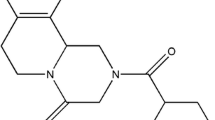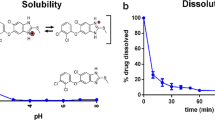Abstract
Polyethylene glycol (PEG) 6000-based solid dispersions (SDs), by incorporating various pharmaceutical excipients or microemulsion systems, were prepared using a fusion method, to compare the dissolution rates and bioavailabilities in rats. The amorphous structure of the drug in SDs was also characterized by powder X-ray diffractometry (XRD) and differential scanning calorimetry (DSC). The ketoconazole (KT), as an antifungal agent, was selected as a model drug. The dissolution rate of KT increased when solubilizing excipients were incorporated into the PEG-based SDs. When hydrophilic and lipophilic excipients were combined and incorporated into PEG-based SDs, a remarkable enhancement of the dissolution rate was observed. The PEG-based SDs, incorporating a self microemulsifying drug delivery system (SMEDDS) or microemulsion (ME), were also useful at improving the dissolution rate by forming a microemulsion or dispersible particles within the aqueous medium. However, due to the limited solubilization capacity, these PEG-based SDs showed dissolution rates, below 50% in this study, under sink conditions. The PEG-based SD, with no pharmaceutical excipients incorporated, increased the maximum plasma concentration (Cmax) and area under the plasma concentration curve (AUC0.6h) two-fold compared to the drug only. The bioavailability was more pronounced in the cases of solubilizing and microemulsifying PEG-based SDs. The thermograms of the PEG-based SDs showed the characteristic peak of the carrier matrix around 60°C, without a drug peak, indicating that the drug had changed into an amorphous structure. The diffraction pattern of the pure drug showed the drug to be highly crystalline in nature, as indicated by numerous distinctive peaks. The lack of the numerous distinctive peaks of the drug in the PEG-based SDs demonstrated that a high concentration of the drug molecules was dissolved in the solid-state carrier matrix of the amorphous structure. The utilization of oils, fatty acid and surfactant, or their mixtures, in PEG-based SD could be a useful tool to enhance the dissolution and bioavailability of poorly water-soluble drugs by forming solubilizing and microemulsifying systems when exposed to gastrointestinal fluid.
Similar content being viewed by others
References
Alden, M., Tegenfeldt, J., and Saers, E. S., Structures formed by interactions in solid dispersions of the system polyethylene glycol-griseofulvin with charged and noncharged surfactants added.Int. J. Pharm., 94, 31–38 (1993).
Attama, A. A., Nzekwe, I. T., Nnamani, P. O., Adikwu, M. Y., and Onugu, C. O., The use of solid self-emulsifying systems in the delivery of didofenac.Int. J. Pharm., 262, 23–28 (2003).
Baxter, J. G., Brass, C., Schentag, J. J., and Slaughter, F. L., Pharmacokinetics of ketoconazole administered intravenously to dogs and orally as ablet and solution to humans and dogs.Pharm. Res., 75, 443–447 (1986).
Betageri, G. V. and Makarla, K. R., Characterization of glyburide-polyethylene glycol solid dispersions.Drug Dev. Ind. Pharm., 22, 731–734 (1996).
Caliph, S., Charman, W. N., and Porter, C. J. H., Effect of short-medium-and long-chain fatty acid-based vehicles on the absolute oral bioavailability and intestinal lymphatic transport of halofantrine and assessment of mass balance in lymph- cannulated and non-cannulated rats.J. Pharm. Sci., 89, 1073–1084 (2000).
Cao, Q.-R., Kim, T.-W., Choi, C.-Y., Kwon, K A., and Lee, B.-J., Preparation and dissolution of PVP-based solid dispersion capsules containing solubilizers.J. Kor. Pharm. Sci., 33, 7–14 (2003).
Chiou, W. L. and Riegelman, S., Pharmaceutical applications of solid dispersion system.J. Pharm. Sci., 60, 1281–1302 (1971).
Constantinides, P. P., Lipid microemulsions for improving drug dissolution and oral absorption: physical and biopharmaceutical aspects.Pharm. Res., 12, 1561–1572 (1995).
Cornaire, G., Woodley, J., Hermann, P., Cloarec, A., Arellano, C., and Houin, G., Impact of excipients on the absorption of Pglycoprotein substratesin vitro andin vivo.Int. J. Pharm., 278, 119–131 (2004).
Franco, M., Trapani, G., Latrofa, A., Tullio, C., Provenzano, M. R., Serra, M., Muggironi, M., Biggio, G., and Liso, G., Dissolution properties and anticonvulsant activity of phenytoin-polyethylene glycol 6000 and polyvinylpyrrolidone K-30 solid dispersions.Int. J. Pharm., 225, 63–73 (2001).
Joshi, H. N., Tejwani, R. W., Davidovich, M., Sahasrabudhe, V. P., Jemal, M., Bathala, M. S., Varia, S. A., and Serajuddin, T. M., Bioavailability enhancement of a poorly water-soluble drug by solid dispersion in polyethylene glycol-polysorbate 80 mixture.Int. J. Pharm., 269, 251–258 (2004).
Kim, T.-W., Choi, C.-Y, Cao, Q.-R., Kwon, K. A., and Lee, B.-J., Dissolution profiles of solid dispersions containing poorly water-soluble drugs and solubilizing compositions.J. Kor. Pharm. Sci., 32, 191–197 (2002).
Morris, K. R., Knipp, G. T., and Serajuddin, A. T. M., Structural properties of polyethylene glycol-polysorbate 80 mixture, a solid dispersion vehicle.J. Pharm. Sci., 81, 1185–1188 (1992).
Mura, P., manderioli, A., Bramanti, G., and Ceccareli, L., Properties of solid dispersions of naproxen in various polyethylene glycols.Drug Dev. Ind. Pharm., 22, 909–916 (1996).
Owusu-Ababio, G., Ebube, N. K., Reams, R., and Habib, M., Comparative dissolution studies for mefenamic acid- polyethylene glycol solid dispersion systems and tablets.Pharm. Dev. Technol., 3, 405–412 (1998).
Porter, C. J. H. and Charman, W. N., Intestinal lymphatic drug transport: an update.Adv. Drug Del. Rev., 50, 61–80 (2001).
Serajuddin, A T. M., Solid dispersion of poorly water-soluble drugs: Early promises, subsquent problems, and recent breakthroughs.J. Pharm. Sci., 88, 1058–1066 (1999).
Sheen, P. C., Khetarpal, V. K., Cariola, C. M., and Rowlings, C. E., Formulation studies of a poorly water-soluble drug in solid dispersions to improve bioavailability.Int. J. Pharm., 118, 221–227 (1995).
Verheyen, S., Blaton, N., Kinget, R., and Mooter, G. V., Mechanism of increased dissolution of diazepam and temazepam from polyethylene glycol 6000 solid dispersions.Int. J. Pharm., 249, 45–58 (2002).
Wang, S.-W., Monagle, J., McNulty, C., Putnam, D., and Chen, H., Determination of P-glycoprotein inhibition by excipients and their combinations using an integrated high-throughput process.J. Pharm. Sci., 93, 2755–2767 (2004).
Author information
Authors and Affiliations
Corresponding author
Rights and permissions
About this article
Cite this article
Heo, MY., Piao, ZZ., Kim, TW. et al. Effect of solubilizing and microemulsifying excipients in polyethylene glycol 6000 solid dispersion on enhanced dissolution and bioavailability of ketoconazole. Arch Pharm Res 28, 604–611 (2005). https://doi.org/10.1007/BF02977766
Received:
Issue Date:
DOI: https://doi.org/10.1007/BF02977766




